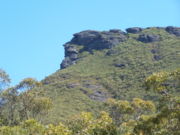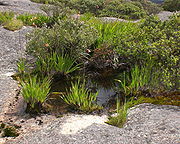
Granite outcrops of Western Australia
Encyclopedia

Monolith
A monolith is a geological feature such as a mountain, consisting of a single massive stone or rock, or a single piece of rock placed as, or within, a monument...
s made from granite
Granite
Granite is a common and widely occurring type of intrusive, felsic, igneous rock. Granite usually has a medium- to coarse-grained texture. Occasionally some individual crystals are larger than the groundmass, in which case the texture is known as porphyritic. A granitic rock with a porphyritic...
that are found across much of Western Australia
Western Australia
Western Australia is a state of Australia, occupying the entire western third of the Australian continent. It is bounded by the Indian Ocean to the north and west, the Great Australian Bight and Indian Ocean to the south, the Northern Territory to the north-east and South Australia to the south-east...
. Rising abruptly from the surrounding landscape they create a variety of microhabitats for plants, and provide seasonal resources and refuge for a range of animals. These areas thus have rich biodiversity
Biodiversity
Biodiversity is the degree of variation of life forms within a given ecosystem, biome, or an entire planet. Biodiversity is a measure of the health of ecosystems. Biodiversity is in part a function of climate. In terrestrial habitats, tropical regions are typically rich whereas polar regions...
and many endemic species
Species
In biology, a species is one of the basic units of biological classification and a taxonomic rank. A species is often defined as a group of organisms capable of interbreeding and producing fertile offspring. While in many cases this definition is adequate, more precise or differing measures are...
. They are significant locations that tie in with the Aboriginal and European cultural heritage of Western Australia
Western Australia
Western Australia is a state of Australia, occupying the entire western third of the Australian continent. It is bounded by the Indian Ocean to the north and west, the Great Australian Bight and Indian Ocean to the south, the Northern Territory to the north-east and South Australia to the south-east...
.
A number of animals are restricted to granite outcrops, including four species of reptile, the mygalomorph spider
Spider
Spiders are air-breathing arthropods that have eight legs, and chelicerae with fangs that inject venom. They are the largest order of arachnids and rank seventh in total species diversity among all other groups of organisms...
Teyl luculentus, and the larva
Larva
A larva is a distinct juvenile form many animals undergo before metamorphosis into adults. Animals with indirect development such as insects, amphibians, or cnidarians typically have a larval phase of their life cycle...
e of the chironomid fly
Fly
True flies are insects of the order Diptera . They possess a pair of wings on the mesothorax and a pair of halteres, derived from the hind wings, on the metathorax...
Archaeochlus. They are also an important habitat of rock-wallabies
Rock-wallaby
The rock-wallabies are the wallabies of the genus Petrogale.-Description:The medium-sized, often colourful and extremely agile rock-wallabies live where rocky, rugged and steep terrain can provide daytime refuge...
such as the Black-flanked Rock-wallaby
Black-flanked Rock-wallaby
The Black-flanked Rock-wallaby , also known as the Black-footed Rock-wallaby or Warru, is a kind of wallaby, one of several rock-wallabies in the genus Petrogale.-Description:...
, and Ctenophorus ornatus
Ctenophorus ornatus
The Ornate Crevice-dragon is a species of lizard in the Agamidae family. It is found on granite outcrops of Western Australia....
, the Ornate crevice-dragon.
Pools of rainwater, known as gnammas, often form on granite outcrops. These provide habitat to around 230 aquatic invertebrate
Invertebrate
An invertebrate is an animal without a backbone. The group includes 97% of all animal species – all animals except those in the chordate subphylum Vertebrata .Invertebrates form a paraphyletic group...
s, of which at least 50 are endemic to these pools, and provide freshwater
Freshwater
Fresh water is naturally occurring water on the Earth's surface in ice sheets, ice caps, glaciers, bogs, ponds, lakes, rivers and streams, and underground as groundwater in aquifers and underground streams. Fresh water is generally characterized by having low concentrations of dissolved salts and...
to other inhabitants and visitors.

Ecological niche
In ecology, a niche is a term describing the relational position of a species or population in its ecosystem to each other; e.g. a dolphin could potentially be in another ecological niche from one that travels in a different pod if the members of these pods utilize significantly different food...
s for many plants. At least 1300 plant species occur on granite outcrops in Western Australia, many of which are endemic to these sites.
Wheatbelt region of Western Australia
- Baladgie Rock
- Beringbooding Rock
- Bruce Rock
- Corrigin Rock
- Eaglestone Hill
- Elachbutting Rock
- Gorge Rock 32°27′S 118°00′E
- Hunts Soak
- Jilakin Rock 32°40′S 118°19′E
- King Rock
- Kokerbin Rock also known as Kokerbin Hill 31°53′S 117°42′E
- Wave Wall, Dog Rock, Devils Marbles
- Mount Walker 32°01′S 118°45′E
- Anderson Reserve, Twine Reserve and Roe Dam
- Sandford Rocks
- The Humps 32°19′S 118°57′E
- Wave RockWave RockWave Rock is a natural rock formation located east of the small town of Hyden in Western Australia that is shaped like a tall breaking ocean wave.Wave Rock has cultural significance to Aborigines...
- Wave Rock, a granite cliff, is 15 metres high and 110 metres long.
- Westonia Common
- Boodalim Soak
Further reading
- (1999) Managing granite outcrops for Western Australia / produced by the Revegetation on Farms Project, AGWEST, with input from CALM and the Royal Society of Western Australia. Narrogin, W.A. : Agriculture Western Australia ("A Project of the Sustainable Rural Development Program of Agriculture Western Australia, contributing to the Western Australian Salinity Action Plan")
- Hopper, S.D., Brown, A.P. and Marchant, N.G. (1997) Plants of Western Australian granite outcrops, Journal of the Royal Society of Western Australia, vo.80:141–158
- Hussey, B. M. J.(1998) 'How to manage your granite outcrops' Como, W.A. : Dept. of Conservation and Land Management, ISBN 0730712036 (pbk.)
- McMillan, Peter.(1990) Exploring granite outcrops written by Peter McMillan, illustrations by Margaret Pieroni, edited by Richard Grant and Carmel Staniland. Como, W.A: Dept. of Conservation and Land Management.
- Withers, P.C. and Edward D.H. (1997) Terrestrial fauna of granite outcrops in Western Australia, Journal of the Royal Society of Western Australia, vol.80:159–166

